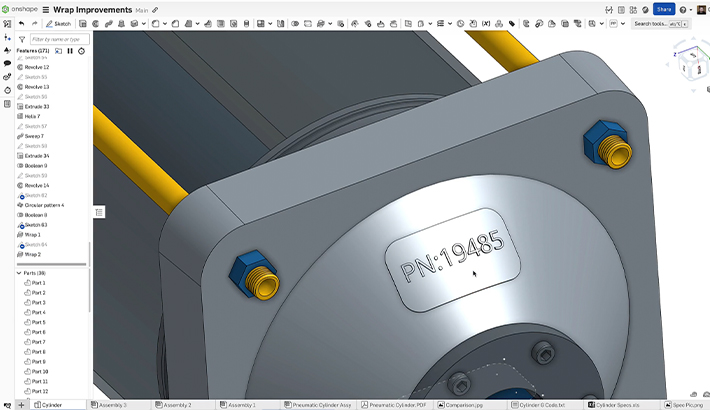Computer-Aided Manufacturing (CAM) is a powerful technology that transforms CAD designs into physical parts by controlling machine tools and related machinery. It plays a crucial role in modern manufacturing by improving precision, efficiency, and repeatability.
The CAM Process
-
CAD Model Creation: Engineers begin by designing a part using CAD software, considering factors such as material properties, tolerances, and manufacturability to ensure efficient machining.
-
Generating Machining Paths: CAM software converts the CAD model into machining toolpaths. Engineers must specify several key parameters, including:
-
Tool Selection: Choosing the right cutting tool based on material hardness, required precision, and machining operation.
-
Material Selection: Defining the workpiece material, which impacts tool wear, cutting speed, and cooling requirements.
-
Feeds and Speeds: Determining the optimal cutting speed and feed rate to balance material removal rate, surface finish, and tool longevity.
-
Cutting Strategy: Selecting the appropriate milling or turning technique, such as roughing for bulk material removal or finishing for fine surface quality.
-

-
Post-Processing: Converts toolpaths into G-code, the machine language that CNC machines execute. Different CNC machines require specific post-processors to translate toolpaths correctly, ensuring compatibility and optimal performance.
Milling and Turning
-
Milling: One of the most widely used machining processes, milling involves a rotating cutting tool that removes material from a stationary or moving workpiece. Common types include:
-
Face Milling: The tool moves perpendicular to the workpiece surface, commonly used for creating flat surfaces and finishing operations.
-
End Milling: The tool engages the workpiece from multiple angles to produce slots, pockets, and detailed contours, offering great versatility.
-
Peripheral Milling: The tool cuts along the edges of the workpiece to shape external contours and profiles.
-
Climb Milling vs. Conventional Milling: Climb milling provides a smoother finish and prolongs tool life, while conventional milling is often better for tougher materials and older machines.
-
Simultaneous Workpiece and Tool Movement: In advanced machining setups, such as multi-axis milling, both the tool and the workpiece can move at the same time, enhancing precision and efficiency, especially in aerospace and automotive applications.
-
-
Turning: Primarily used for producing cylindrical components like shafts and pipes, turning involves rotating the workpiece while a stationary cutting tool removes material.
-
Mill-Turning: This hybrid approach integrates milling and turning capabilities, enabling the machining of complex parts in a single setup, reducing production time and improving accuracy.
TECH TIP: Create a Machine Tool in Onshape CAM Studio
How Machining Motion Defines Types
The classification of machining types is determined by the movement of the cutting tool relative to the workpiece. Machining operations are generally defined by linear movement along the X, Y, and Z axes and rotational movement around those axes. Additionally, the ability to perform these motions simultaneously during cutting influences machining complexity, precision, and efficiency.
Different Types of Machining with Examples
-
2.5-Axis Machining: Typically used for prismatic parts like brackets, where the tool moves in X and Y while adjusting Z in discrete steps. This method is ideal for drilling, slotting, and pocket milling where depth changes occur incrementally.
-
3-Axis Machining: The most common type of CNC milling, allowing simultaneous movement in X, Y, and Z. It enables the creation of complex contours, such as molds and intricate mechanical components, widely used in aerospace and medical industries.
What's the Difference Between 2.5 and 3-Axis Machining?In 2.5-axis machining, the tool can move in X and Y while the Z-axis is adjusted in steps rather than continuously. This means that while the tool can reach different depths, it cannot simultaneously move in all three axes. This is commonly used for applications like pocket milling, drilling, and slotting, where flat-bottomed features are needed at multiple depths. In 3-axis machining, the tool can move simultaneously in X, Y, and Z, enabling smooth and continuous cutting across all three dimensions. This allows for the machining of complex contours, curved surfaces, and detailed 3D features. It is widely used in mold making, medical device manufacturing, and other industries requiring freeform surfaces and intricate details. |
-
3.5-Axis Machining: Adds controlled tilting in one axis, useful for machining angled features without the need for full 5-axis capability. This provides increased flexibility for complex housing components and angled holes.
-
4-Axis Machining: Adds a rotational axis, often around the X or Y axis, allowing the workpiece to rotate for more efficient multi-face machining. This is frequently used for camshafts and turbine blades.
-
5-Axis Machining: Provides the highest level of flexibility, allowing movement along all three linear axes and two rotational axes. This enables machining of intricate, highly detailed components in a single setup, reducing errors and improving efficiency, particularly in aerospace and advanced manufacturing.
Enter Onshape CAM Studio
Onshape users now have the benefits of integrated CAM, built directly into the same cloud-native system that is redefining agile hardware design. With Onshape CAM Studio, teams can seamlessly transition from design to manufacturing without the need for file transfers or additional software integrations. This fully integrated approach enhances collaboration, reduces errors, and streamlines the entire workflow, ensuring that manufacturing teams can operate with the same agility and efficiency as their design counterparts.
Onshape's cloud-based architecture ensures that CAM programming, like CAD modeling, is always up to date, accessible from any device, and fully version-controlled. Engineers can work concurrently, make real-time adjustments, and instantly see the impact of design changes on machining strategies. This integration eliminates traditional bottlenecks and helps teams accelerate product development cycles while maintaining high precision and manufacturing efficiency.
An Essential Technology
CAM is essential in modern manufacturing, ensuring precision, efficiency, and repeatability. It enables engineers to bring designs to life with confidence, optimizing workflows and minimizing costly errors.














